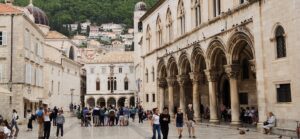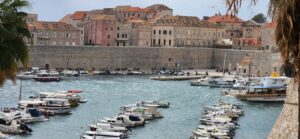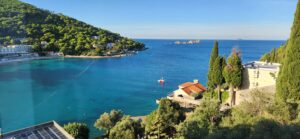Due east of Rome and across the Adriatic Sea you will find the small, historic city of Dubrovnik. In its long-past commercial heyday, it was a colony of the Venetian empire. There are still many Italian influences in its architecture and cuisine, while the language is most definitely of Slavic origin. It was a popular tourist destination in the 19th and early 20th centuries, welcoming travelers such as Lord Byron and Agatha Christie. War and ethnic rivalry kept visitors away until after the Second World War, and even then a trip to Tito’s Yugoslavia wasn’t everyone’s idea of a good time. With the dissolution of Yugoslavia in the early 1990’s, Dubrovnik suffered terribly from Serbian attacks. It was only with peace that the “Pearl of the Adriatic” was (re)discovered.
The main square of Dubrovnik
Most visitors are attracted to Dubrovnik’s Old Town, a UNESCO World Heritage site. This was where the Venetians reigned and it still has vestiges of Venice, without the canals. There are a few squares, some grand and some petite. Most of the Old Town is in a narrow valley between a small hill on one side and a really steep one on the other. The streets are narrow and packed with tourists following guides with their ubiquitous flags and umbrellas held high. We understand that the streets are impassible in the summer. Even in cooler weather, there are many visitors.
Dubrovnik’s harbor, with a portion of the walls.
The most renowned monuments in Dubrovnik is the first that you see when you approach the Old Town, the medieval walls around it. These are as much as 25 meters (around 82 feet) high and more than a mile around the town. Visitors can tour the walls but be prepared to climb 25 meters of stairs to get there. Still, there are many pleasant sights and vistas all around the town.
Of course, where there are walls there must be gates, and there are two into the Old Town. You get to cross an actual drawbridge and consider how difficult it must have been for attackers to breach the city before artillery and airpower. Once inside, there are more than enough shops and restaurants to keep visitors occupied for days, though there is a limit to how much octopus, squid and Plavac Mali wine anyone can take. Many of the restaurants are on narrow streets on the hillsides. It can feel cozy or claustrophobic, depending on your outlook. We particularly enjoyed the ones that had a view of the harbor.
A view of the coast of Dubrovnik.
There is another aspect of Dubrovnik that should not be overlooked. It is a coastal city with excellent beaches and paved promenades that run along the cliffsides. Many Europeans consider it more of a resort town; they have enough history where they come from.
The promenades are not made for dedicated hikers. They are well paved and lit at night. But they are for those who enjoy seeing natural beauty. It is possible to go down rather vertical stairways to sit on the rocks on the sea. We preferred to stop at wine bars along the way and look at the sea from above.
It is possible to experience Dubrovnik in a few days. It’s a destination you should put on your travel bucket list.


